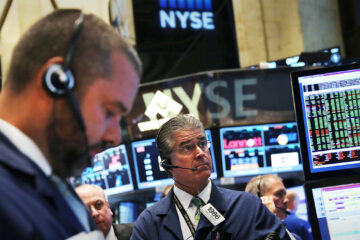It’s recently been a tough stretch for bond and equity investors. Treasury yields and stocks have fallen since mid-July because of worries that stubborn inflation would require the Federal Reserve to keep rates higher for longer, and the Government will have to issue more bonds because of soaring spending.
Unfortunately, it could remain a rocky road for investors.
At the J.P. Morgan Robin Hood Investors Conference last week, billionaire hedge fund manager Stanley Druckenmiller told fellow billionaire Paul Tudor Jones that if rates stay where they are now, the interest paid on U.S. debt would climb to 4.5% of GDP by 2033, causing tough decisions unlikely to sit well with millions of Americans.
The U.S. Government’s mounting debt could pose significant problems in the long term.
Getty
The U.S. faces a big debt problem
When you’re in a hole, stop digging. That’s wise advice, but sadly, it’s not being followed by legislators. Despite U.S. debt surging over the past three years because of COVID-era spending programs, Congress continues to write bigger checks, creating a problem that’s becoming increasingly harder to fix.
Related: Single Best Trade: Hedge fund manager Doug Kass gives his top pick now
The hole wouldn’t be as deep if the government had reined in spending when employment was low and focused on issuing long-term instead of short-term debt when rates were near rock bottom.
“It really started with Donald Trump running a full employment deficit of over $1 trillion deficit,” said Druckenmiller. “If that wasn’t enough, Biden came in and we got Covid. He doubled and tripled down on Federal spending. What’s amazing is he’s still at it.”
The government’s addiction to spending has lifted U.S. debt to over $33 trillion, a number that’s likely to put a lot of pressure on the economy in the future because of interest payments. The payments wouldn’t be nearly as onerous if the Treasury had borrowed using long bonds when rates were low.
More Wall Street analysis:
Tesla analyst who told investors to ‘nail down profits’ in August has a new price targetAnalyst who predicted Nvidia’s rally has a new price target (many investors won’t be happy)Hedge Fund Manager Doug Kass correctly said to sell stocks in July; here’s what he’s doing now
“When rates were practically zero, every Tom, Dick, Harry, and Mary in the U.S. refinanced their mortgage. Unfortunately, we had one entity that did not and that’s the U.S. Treasury,” said Druckenmiller. “Janet Yellen, I guess because of political myopia or whatever, was issuing two years at 15 basis points when she could’ve issued 10 years at seventy basis points or 30 years at 180 basis points. I literally think if you go back to Alexander Hamilton, it was the biggest blunder in the history of the Treasury. I have no idea why she has not been called out on that. She has no right to still be in that job after that.”
The amount of debt and the interest payments associated with it relative to the U.S. economy is eye-popping. In 2022, the federal government’s interest expense was $476 billion, up 35% from 2021 and equal to about 2% of gross domestic product (GDP).
“When the debt rolls over, by 2033, interest expense is going to be 4.5% of GDP, if rates are where they are now,” said Druckenmiller. “By 2043, sounds like a long time, but it’s really not; 20 years, interest expense as a percent of GDP will be 7%. That is 144% of all current discretionary spending.”
It’s hard to imagine how the government will handle paying that bill without draconian changes to taxes or government programs.
“The politicians that are telling you and think they’re not going to cut entitlements, it’s just an outright lie,” said Druckenmiller. “The numbers absolutely don’t work. It’s a fantasy.”
Druckenmiller says it will require sacrifices to get the math to work again, but nobody wants to do that.
Get investment guidance from trusted portfolio managers without the management fees. Sign up for Action Alerts PLUS now.


